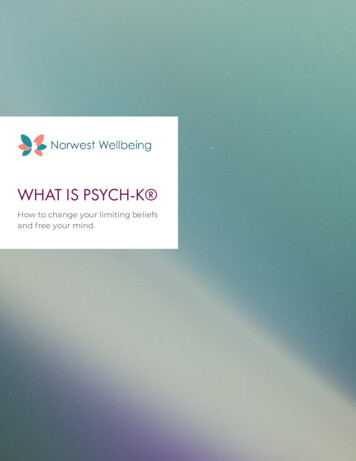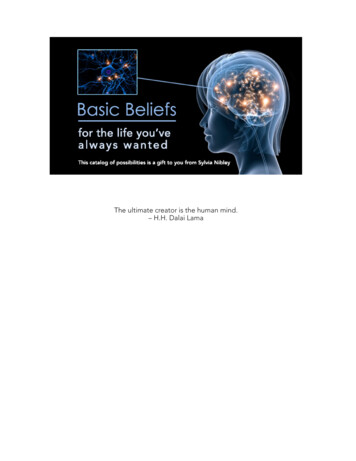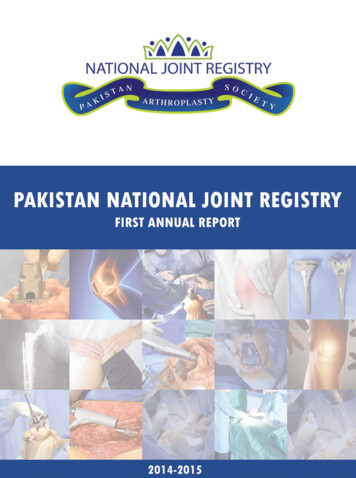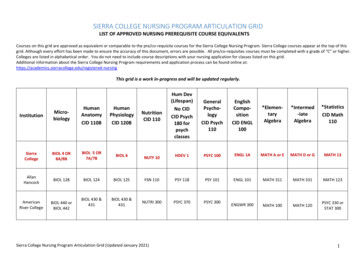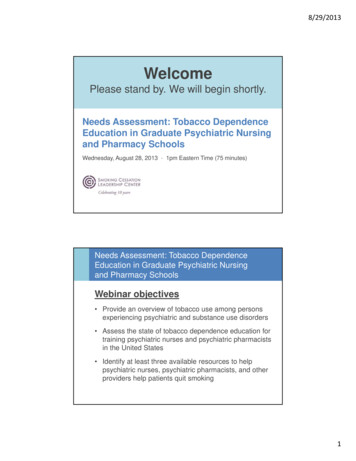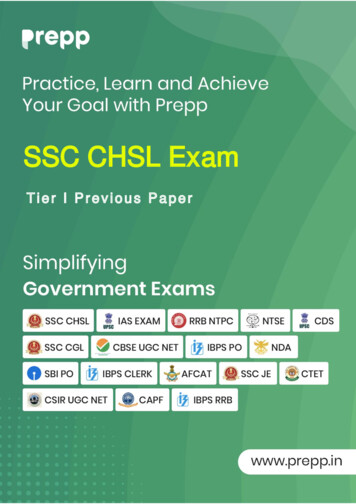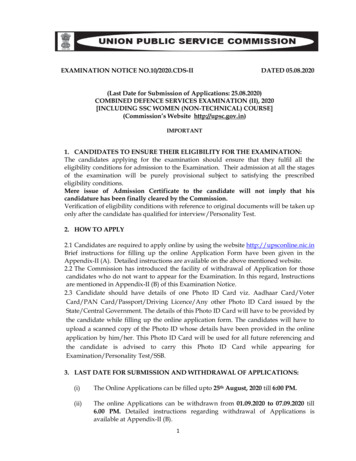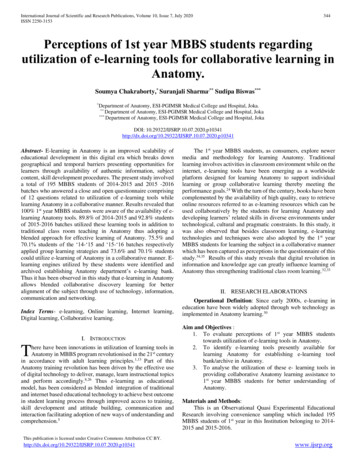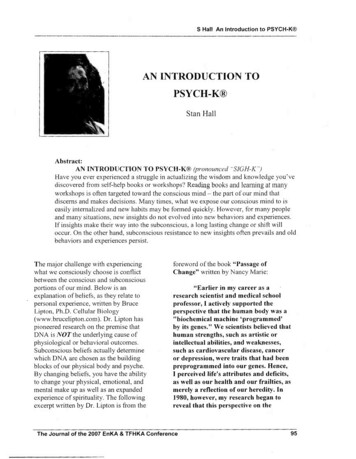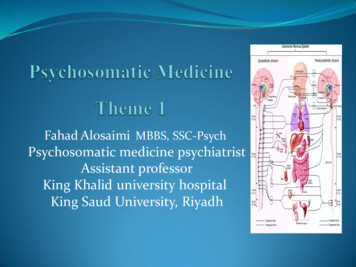
Transcription
Fahad Alosaimi MBBS, SSC-PsychPsychosomatic medicine psychiatristAssistant professorKing Khalid university hospitalKing Saud University, Riyadh
Case Development 3 Past medical and psychiatric history indicated that thepatient has left side CVA 7 years ago. Post stroke, he had 3 months history of low mood, loss ofinterest, crying spells, excessive guilt feelings and deathwishes. Moreover, he had decreased sleep, appetite, energy andconcentration. He became isolated and not cooperative duringphysiotherapy session. After been assessed andmanaged by psychosomatic psychiatrist, patient’s moodand motor function have improved very well.
Discussion of the case Analyze the symptoms (presented and expected) inthis case and signs, including mood, thoughts,cognition, perception and physical aspects Discuss other elements related to the case includespossible etiological reasons Discuss the initial possible diagnosis of this case anddifferent types of such clinical presentation
Stroke After stroke, 25 to 40% of patients meet criteriafor Depression. Studies in the 80’s and 90’s demonstrated thatpost-stroke depression (PSD) was associatedwith left frontal brain lesions, worse physical andcognitive recovery, and increased mortality. These depressions were shown to be treatablewith antidepressants and successful treatmentled to both improved recovery and survival. There have now been 8 controlled trials showingPSD may be treated and prevented effectivelywith citalopram, nortriptyline, or reboxetine.
Stroke Recently, antidepressants : improve physicaland cognitive recovery over one yearindependent of depression. Over seven years, antidepressants have beenshown to decrease mortality by almost 50%even among non-depressed patients .How? Inflammatory proteins are released both bystroke and depression and can have long lastingeffects on brain function. Antidepressants have been shown to decreasethese Inflammatory proteinsneurogenesis and synaptogenesisimproved recovery and decreased mortalityfollowing stroke.
Next . Introduction about psychosomatic medicine. Discuss about Depression in medical ill patients. Discuss about Psycho-pharmacology inmedically ill populations
Psychosomatic medicine is the subspecialty of psychiatrywhose practitioners have particular expertise in the diagnosisand treatment of psychiatric disorders and difficulties incomplex medically ill patients (Gitlin et al. 2004) Psychosomatic medicine resides at the interface of physicaland mental illness. The clinical practice of psychosomatic medicine issometimes called consultation-liaison psychiatry (CLP) Since 2001, Psychosomatic medicine has become asubspecialty recognized by the American Board of MedicalSpecialties
Medical factors/illnesses may affect individual vulnerability,course, & outcome of ANY psychiatric disorder. Psychosocial factors/illnesses may affect individualvulnerability, course, & outcome of ANY type of disease. Psychological factors may operate to facilitate, sustain, ormodify the course of medical disease , even though their relativeweight may vary from illness to illness !. form one individual to another !. between 2 different episodes of the same illness in the sameindividual! .
Illness Vs. Disease Illness:-The response of the individual and his/her familyto symptoms-Subjective !, psychosocial, cultural, religiousfactors Disease:-Defined by physicians and associated withpathophysiological processes and documented lesions-Objective ! Implications !!
Illness Behavior The manner in which individuals monitor their bodies,define and interpret their symptoms, take remedialactions, and utilize the health care system Variety of factors Achievement of objectives Abnormal illness behavior:Inappropriate or maladaptive mode of perceiving,evaluating or acting in relation to one’s own health statusIllness affirming illness denying
Example of psychosocial factorsaffecting a medical d (CHD)According to The Interheart study, the populationattributable risk factor for MI of Hypertension was17.9% , while the psychosocial risk factors, wereresponsible about :a) 5%b)10%c) 15%d)20%e) 30%
Stress Vs CHDAccording to The Interheart study, the populationattributable risk factor for MI of Hypertension was17.9% , while the psychosocial risk factors, wereresponsible about :a) 5%b)10%c) 15%d)20%e) 30%
INTERHEART Study (EPIDEMIOLOGY, stress &CHD)Case controlstudy of:n 29000 in52 countries.**Effect of potentially modifiablerisk factors associated withmyocardial infarction in 52countries (the INTERHEARTstudy): case-control study. YusefS et al. Lancet 2004Percent4035302520151050The Population attributable risk for MI %The Populationattributable risk for MI%
Advantages of psychosomaticmedicine (CLP) service1-Releive symptoms of distress & improve the qualityof life of some patient with serious diseases.2- May improve the course and prognosis of severalmajor medical illnesses3-Cost-effective :A- Reduce the length of hospital stay.B-Reduce the number of unnecessaryinvestigations (performed for physical symptomsthat may actually reflect underlyingpsychological distress ).
ApproachHow to do it (effective psych. Consultation)1-Review patient charts, asking nurses and physician.2-Obtain good psychiatric history (paying attention topsychological & social factors).3-MSE & MMSE if cognitive problem is suspected andpossibly neuropsychological assessment.
ApproachHow to do it (effective psych. Consultation)4-Making logical differential diagnosis among medical ,neurological and psychiatric diseases (use multi-axial Dx.)5-Investigate based on that.6-Make treatment plan.7-Follow up plan ( as inpatient & outpatient).8-Collaborate with both the patient and the referring team.
Quality of life and illness Intrusiveness(G. Devins,1994)Disease related factorsControlIllnessintrusivenessTreatment relatedfactorsPsycho-social factorsSubjective wellbeing
Clues Suggestive of “Organic” MentalDisorders(Psychiatric disorder 2ndary to generalmedical condition) History: Psychologicalsymptoms occurring New onset psychiatric symptoms presenting after age 40. During the course of a major medical illness which had impaired some organfunction (e.g., neurological, endocrine, renal, hepatic, cardiac, pulmonary). While taking medications/illicit substance, he had psychoactive effects. Family history of: -ve for primary psychiatric illness. ve for medical disease that may present with psychiatric symptoms e.g.:-Degenerative or inheritable neurological disorders(e.g., Alzheimer’s disease, Huntington’s disease)-Inheritable metabolic disorders (e.g., DM,Pernicious Anemia, Porphyria)
Clues Suggestive of Psychiatric disorder 2ndaryto general medical condition Clinical Exam: Abnormal vital signs. Evidence of organ dysfunction, focal neurological deficits. Eye exam: Pupilary changes—asymmetries Nystagmus (often a sign of drug intoxication) Presence of altered states of mind, LOC, mental status changes, cognitiveimpairment; episodic, recurrent, cyclic course Presence of visual, tactile or olfactory hallucinations Signs of: Cortical dysfunction (e.g., dysphagia, apraxia, agnosia) Diffuse subcortical dysfunction(e.g., slowed speech/mentation/movement, ataxia, incoordination, tremor, chorea,asterexis, dysarthria)
Depression & medicalillnessesDepressionStressMedicaldisorder
SELECTED EPIDEMIOLOGIC STUDIES OF DEPRESSIONASSOCIATED WITH MEDICAL ILLNESSReferenceBurvill et al. (1995)Robinson et al. (1984)IllnessPrevalence ofdepression t27 (Major depression)20 (Minor depression)Sano et al. (1989)Parkinson disease51Greenwald et al. (1989)Alzheimer disease11Schleifer et al. (1989)Myocardial infarction18 (Major depression)27 (Minor depression)Frasure-Smith et al.(1993)Myocardial infarction16Hance et al. (1989)Coronary artery disease(CAD)17
Depression plus Medically illnessIs it serious? Poor outcomes of the medical illness Increased mortality in cardiovascular disease, stroke,diabetes, and ?cancer Chronic medical conditions and depression are interrelatedand that treatment of one condition can affect the outcomesfor the other. Worse adherence to medical regimens, tobacco smoking,sedentary lifestyle, and overeating. Increased functional disability, decreased self-care. Four to five times greater levels of morbidity, prematuremortality, health services use and health care expenditurescompared to non- depressed patients with no GMC.*Lin EH. Et al. Gen Hosp Psychiatry. 2006;28:482-486
Pathophysiology :Relation BTdepression & medical illnesses There are multiple physiological responses tostress: hyperactivity of the hypothalamic- pituitary- adrenal(HPA) axis. immune activation with release of proinflammatorycytokines. activation of the sympathetic nervous system.
Signs of Depression IN MEDICALLY ILLisolationdepressed moodinsomniaweight losscryingguilt feelingspoor or increased appetiteSad appearanceless communicationpoor concentrationdeath wishesloss of follow up andtreatmentNo healthy life stylePoor socialcommunicationRestlessnessLoss of productivity
DIFFERENTIALDIAGNOSIS1) Mood disorder due to a general medical condition, with2)3)4)5)6)depressive features.Substance-induced mood disorder, iatrogenic versusother substances, with depressive features.Bipolar I/II disorder, most recent episode depressed.Major depressive episode(uni polar).Dysthymic disorder.Adjustment disorder with depressed mood ( common inmedical setting).
Examples ofDepression inmedically ill patients
EPIDEMIOLOGY (depression& coronary heart disease)Depression has repeatedly been found to predict :early-onset CHD.post-MI mortality (1.5- 5.07 times risk), esp. severeand chronic types.e.g. (HAM-Depression) scale score in first 2 weeks postCHD event predict 7 years mortality risk.increased CHD symptoms(chest pain, fatigue).noncompliance on exercise/medication/smoking .Glassman AH , et al ,Psychiatric characteristics associated with long-term mortality among 361 patients having an acute coronarysyndrome and major depression: seven-year follow-up of SADHART participants, Arch Gen Psychiatry, Sep 2009Keteyian SJ. Cardiovascular symptoms in coronary-artery disease patients are strongly correlated with emotional distress.]Psychosomatics,2008
Pathophysiology (depression &CHD)
Pathophysiology (Behavioural)Physical inactivity.Smoking.High carbohydrate & high fat diet.Poor adherence to medications.Social isolation.
Depression & diabetes
Prevalence of Diabetes among patients withmajor psychiatric disordersJ Affect Disord. 2002 Jun;70(1):19-26.
Bi-directional Relationship:Independent of multiple confoundingfactorsType IIDiabetesDepression is associated with a 60 – 65%increased risk to develop Type II DiabetesDepression(Campayo et al. 2010; Mezuk et al. 2008; Musselman et al.2003)
Type II Diabetes is associated withhigher prevalence of depressionDepression2 – 3 x higher prevalence than in generalpopulationType IIDiabetesMezuk et al. 2008
Summary (Depressionin medically ill) Historically, depression in the medically ill was oftenconsidered a natural and expected response to medicalillness. Treatment of depression was often consideredsecondary to treatment of the medical illness, if thedepression was even treated at all. Today, this perspective can no longer be accepted. Depression is a systemic disease. The effect of depression on the course of medical illnessis multifaceted because there are systemicpathophysiologic implications, as well as psychologicaland behavioral ramifications.
Summary (Depressionin medically ill) The accurate diagnosis and appropriate treatment ofdepression in the medically ill improves quality of life,enhances the patient's ability to be actively engagedin his or her treatment, decreases symptom quantityand severity, and decreases cost utilization. Most important, it decreases morbidity and mortality.
Four important messages ABOUTMEDS in ESRD Most psychotropic medications are fat soluble, easily pass the bloodbrain barrier, are not dialyzable, are metabolized primarily by theliver, and are excreted mainly in bile. The majority of these drugs can be safely used with the ESRDpopulations. Dosing often involves trial and error. The majority of patients withESRD both tolerate and require ordinary doses of most psychotropicmedications. Toxicity is usually obvious, and we would caution more againstundermedicating patients than against overmedication. Cohen LM. Update on psychotropic medication use in renal disease. Psychosomatics. 2004
Summary ofpsychopharmacology forpatients with liver disease To guide pharmacotherapy in liver disease, use Childs-Pugh scoreswith closer monitoring to help to increase safety and tolerability. When choosing psychotropic agents for patients with liver disease,consider the following: Drug interactions e.g : NSAIDs SSRI for GI bleed Medical Disease E.g : Severity of liver disease, protein binding Age : e.g. : Decreased risk hepatotoxicity in adults Drug profile E.g.: Hepatotoxicity, hyperammonemia Hepatic modifications E.g: Bupropion vs. citalopramSanjeev Sockalingam, psychopharmacology updates, 2009
Case Development 4 Elaborating more in his past history, His wife reportedthat when she was pregnant with her last child 27 yearsago, she has needed to get help of psychiatry -becauseof sadness, crying, anxiety and disturbed sleeping. Also, after delivery, she became behaviorally disturbedplus hearing voices asking her to kill her child.
Analyze the symptoms (presented and expected) inthis case and signs, including mood, thoughts,cognition, perception and physical aspects Discuss other elements related to the case includespossible etiological reasons Discuss the initial possible diagnosis of this case anddifferent types of such clinical presentation
Perinatal psychiatry
CONSEQUENCES OFDEPRESSION IN PREGNANCYMother Suicide unhealthy practices e.g.smoking Poor nutrition Less compliant withprenatal care Increased pain ,nausea,stomach pain, SOB, GIsymptoms.etcBaby low birth weight, smaller headcircumferences, premature delivery,etc poor mother-infant attachment,delayed cognitive and linguisticskills, impaired emotionaldevelopment, and behavioral issues emotional instability and conductdisorders, attempt suicide, andrequire mental health services
Depression inpregnant Women 10% to 16% of pregnant women fulfill the diagnosticcriteria for MDD, and even more women experiencesubsyndromal depressive symptoms Many of depressive symptoms overlap with thephysical and mental changes experienced duringpregnancy
The American Psychiatric Association and the American Collegeof Obstetricians and Gynecologists2009 Report True association between maternal SSRI use and reduced infant birthweight Longer exposures are more likely to decrease gestational age NO association between TCA use in pregnancy and structuralmalformations SSRIs : exposure show NO consistent information to support specificmorphological teratogenic risks.
Presumed associations between antidepressants andmalformations may be complicated by poly-druginteractions Bupropion, venlafaxine, duloxetine, nefazodone, andmirtazepine: NO statistically significant difference orhigher than expected rate of congenital anomalies ECT has long been regarded as a safe and effectivetreatment for severe depression, life threateningdepression, or failure to response to antidepressant drugs
Treatment of mania &psychosis during pregnancy Typical antipsychotics esp. high potent consideredas relatively safe compared to other medications. Atypical antipsychotics: no major malformations werefound. However, limited data so far, Metabolicsyndrome is more with olanzapine and clozapine. Lithium is considered first line mood stabilizer duringpregnancy despite rare cardiac anomaly. Lamotrigine is the safest anticonvulsants moodstabilizers. Avoid valproate & carbamazepinein child bearingwomen and pregnancy
Why to avoid Valproate in childbearing women and pregnancy? Neural tube defects secondary to interference withfolate metabolism with first trimester exposure– Risk 7-16% Craniofacial defects: mid-face hypoplasia, short nosewith anteverted nostrils, and long upper lip Hypoglycemia, hepatic dysfunction, fingernailhypoplasia, cardiac defects, cleft palate, hypospadias,polydactyly Neonatal toxicity possible Significantly lower mean IQ and verbal IQ
NONPHARMACOLOGIC TREATMENTS Psychotherapy: is considered to be an evidence-basedtreatment of mood disorders Mild depression: interpersonal psychotherapy (IPT) orcognitive behavioral therapy (CBT), both having solidevidence-based outcomes data for the treatment ofdepression. Couples counseling
POSTPARTUM DEPRESSION 10% to 20% of women who give birth Undetected and commonly underdiagnosed Continuum of Affective Symptoms‘‘baby blues’’ postpartum psychosis
TREATMENT OF POSTPARTUM DEPRESSION SSRIs are medications prescribed most commonly butother agents should be considered ?More positive response to SSRIs and Venlafaxine,than to TCAs Pharmacotherapy should continue for at least 6months to prevent a relapse of symptoms Breastfeeding: All antidepressants are secreted tosome degree into the breast milk! Paroxetine and sertraline: Infant serum levels are lowto undetectable
Fluoxetine : higher rate of secretion into breast milk,long half-lives of metabolites, they can accumulate inan infant’s blood, reaching detectable levels* NOT considered the first-line SSRI for breastfeedingwomen Mirtazapine: no negative effects on infants withmaternal use* Research on long-term effects of SSRI and TCAexposure through breast milk on children shows NOalteration in IQ, language development, or behavior** IPT and CBT are effective.*Kristensen JH. et al. Br J Clin Pharmacol 2007;63:322**Hale TW. Neo Reviews 2004;5:E451
Postpartum Psychosis Rare: 1 in 500-1000 deliveries. Typically presents within 2 weeks of delivery. Often is a manifestation of bipolar disorder. Signs/symptoms: Severe insomnia, Rapid moodswings, Anxiety, Psychomotor restlessness,Delusions (childbirth themes) ,hallucinations,cognitive disturbance, neglecting the infant. Assess for suicidal, homicidal/ infanticidal ideations. Treatment: mostly similar to Tx of bipolar disorder,consider ECT.
Case Development 4 At that time (27 years ago), our patient(Abdullah) started to complain of multiple painsin his body associated with headache anddizziness. He spent his saving for medical checkup foryears with no conclusive results tell he was methis psychiatrist and he started to improve.
Analyze the symptoms (presented and expected) inthis case and signs, including mood, thoughts,cognition, perception and physical aspects Discuss other elements related to the case includespossible etiological reasons Discuss the initial possible diagnosis of this case anddifferent types of such clinical presentation
Somatoform disorders
Medically unexplained 06-workup
Somatoform DisordersThree enduring clinical features:- Somatic complaints that suggest major medicalproblems.- Psychological factors and conflicts that seemimportant.- Symptoms or magnified health concerns that are NOTunder the patient’s conscious control.
IOrganic cause?Not exp. Substance abuse?Other psychiatric dis.?IINeurological symptomconversionIIIPain predominantPain disorderIVToo busy with diseaseHypochondriasisVMany symptomsSomatization dis.VIIntentional symptomsFactitious /MalingeringCommon Psychiatric Problems in Family Practice Somatoform Disorders Dr. Zekeriya Aktürk
Etiology of somatoform D
Management of somatoform disordersDoAVOID Allow patient role Concentrate on functions Frequent, short visits Single doctor Group therapy May individual Tx Drug treatment for psychco-morbidity. SSRIs, high doses forHypochondraisis and BDD Concentrating onSymptoms. Say (It’s just in your mind,take it easy.) Tests or Rx without Dx Unnecessary Referrals /consults.
Future of Psychiatry
Psychosomatic medicine resides at the interface of physical and mental illness. The clinical practice of psychosomatic medicine is sometimes called consultation-liaison psychiatry (CLP) Since 2001, Psychosomatic medicine has become a subspecialty recognized by the American Board of Medical Specialties
